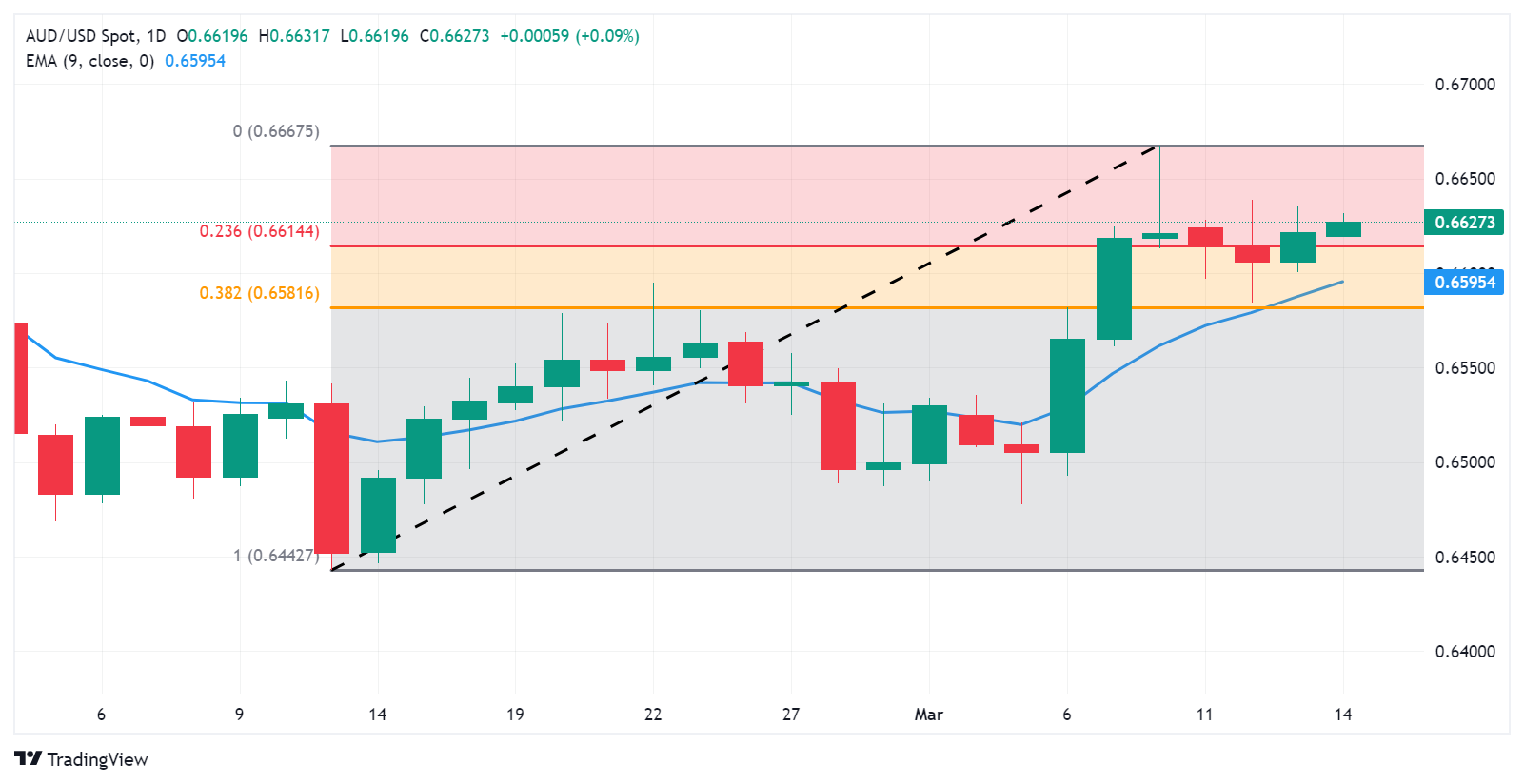- Australian Dollar trims its intraday gains on the lower domestic equity market.
- Australia's S&P/ASX 200 Index tracks declines in the financial-linked shares, outweighing iron ore miners.
- CME FedWatch Tool suggests the probability of a rate cut in March and May has decreased to 1.0% and 9.6%, respectively.
The Australian Dollar (AUD) shifts into negative territory after relinquishing its earlier intraday gains on Thursday. However, the AUD/USD pair strengthened due to expectations of the Federal Reserve (Fed) initiating interest rate cuts in June, while the Reserve Bank of Australia (RBA) continues to suggest it may need to raise rates even further. RBA Governor Michelle Bullock recently stated that inflation in Australia is primarily "homegrown" and "demand-driven," attributable to the strength of the labor market and increasing wage inflation. The RBA does not anticipate inflation falling back to target until 2026.
Australian Dollar could have faced downward pressure due to the lower S&P/ASX 200 Index, driven by declines in the financial sector that outweigh the gains in iron ore miners. Shares linked to the Australian financial sector, including Westpac Banking, Commonwealth Bank, ANZ Group, National Australia Bank, and Macquarie Group, are leading the losses. Traders are awaiting the release of the US Core Producer Price Index (PPI) and Retail Sales data scheduled for Thursday, which could further influence market sentiment and the direction of the AUD/USD pair.
Daily Digest Market Movers: Australian Dollar faces pressure from a weaker equity market
- Australia's NAB Business Confidence Index decreased to 0 in February, from 1 in the previous month.
- Australia's NAB Business Conditions Index improved to 10 from the previous reading of 7 (revised from 6).
- Former RBA Governor Philip Lowe stated on Wednesday that there is a two-way risk on interest rates, supporting current RBA Governor Michelle Bullock's warning that interest rates might still need to increase.
- Chinese Foreign Minister Wang Yi is scheduled to meet with Australia's Foreign Affairs Minister Penny Wong in Canberra on March 20. The discussions are expected to cover various topics, including economic issues such as the removal of trade barriers, as well as more sensitive issues like human rights and regional security.
- US Treasury Secretary Janet Louise Yellen remarked that it appears unlikely for interest rates to revert to levels as low as those before the Covid-19 pandemic. She also noted that the interest rate assumptions outlined in Biden’s budget plan were deemed "reasonable" and aligned with a broad spectrum of forecasts.
- According to the CME FedWatch Tool, the probability of a rate cut in March has decreased to 1.0%, while in May it stands at 9.6%. The likelihood of a rate cut in June and July is estimated to be 67.2% and 84.2%, respectively.
- US CPI (YoY) came in at 3.2% in February, exceeding estimates of 3.1% and above January’s 3.1%. The monthly index printed 0.4% as expected above 0.3% prior.
- US Core CPI increased by 3.8% year-over-year, above the expected 3.7% but below the previous 3.9% reading. While MoM remained consistent at 0.4% against the expected 0.3%.
- The Monthly Budget Statement printed a deficit of $296 billion in February, below the expected deficit of $299 billion. However, it has sharply increased from the previous deficit of $22 billion.
Technical Analysis: Australian Dollar extends gains to near 0.6630
The Australian Dollar traded near 0.6630 on Thursday. Major resistance appears at the level of 0.6650, followed by the previous week’s high of 0.6667. A breakthrough above the latter could provide further momentum for the pair to challenge the psychological barrier of the 0.6700 level. On the downside, the AUD/USD pair could find immediate support at the 23.6% Fibonacci retracement of 0.6614 level, followed by the psychological level of 0.6600. and the nine-day Exponential Moving Average (EMA) at 0.6595. Further support lies at the 38.2% Fibonacci retracement level of 0.6581.
AUD/USD: Daily Chart

Australian Dollar price today
The table below shows the percentage change of Australian Dollar (AUD) against listed major currencies today. Australian Dollar was the weakest against the New Zealand Dollar.
| USD | EUR | GBP | CAD | AUD | JPY | NZD | CHF |
| USD |
| 0.07% | 0.03% | 0.02% | 0.11% | 0.14% | -0.01% | 0.03% |
| EUR | -0.07% |
| -0.03% | -0.06% | 0.04% | 0.06% | -0.10% | -0.03% |
| GBP | -0.03% | 0.04% |
| -0.03% | 0.08% | 0.09% | -0.06% | 0.01% |
| CAD | -0.02% | 0.08% | 0.03% |
| 0.09% | 0.12% | -0.04% | 0.01% |
| AUD | -0.12% | -0.07% | -0.11% | -0.11% |
| 0.01% | -0.12% | -0.08% |
| JPY | -0.14% | -0.07% | -0.10% | -0.12% | -0.01% |
| -0.16% | -0.10% |
| NZD | 0.01% | 0.09% | 0.04% | 0.03% | 0.14% | 0.15% |
| 0.08% |
| CHF | -0.05% | 0.02% | -0.01% | -0.03% | 0.06% | 0.09% | -0.06% |
|
The heat map shows percentage changes of major currencies against each other. The base currency is picked from the left column, while the quote currency is picked from the top row. For example, if you pick the Euro from the left column and move along the horizontal line to the Japanese Yen, the percentage change displayed in the box will represent EUR (base)/JPY (quote).